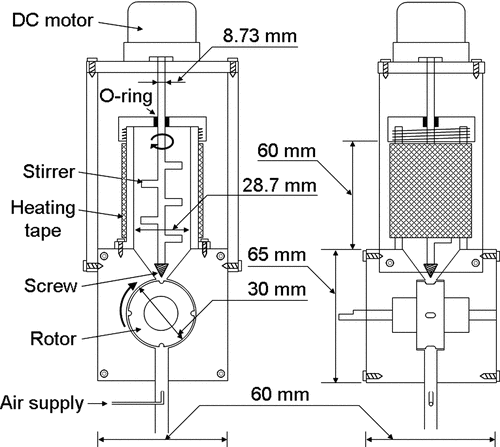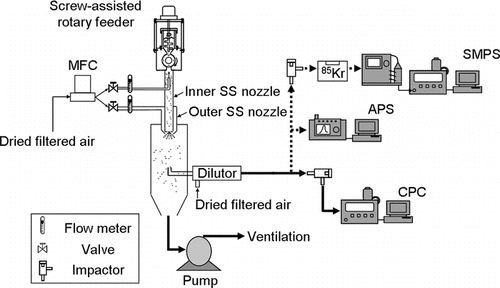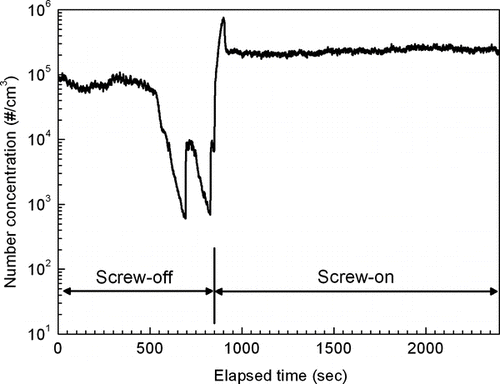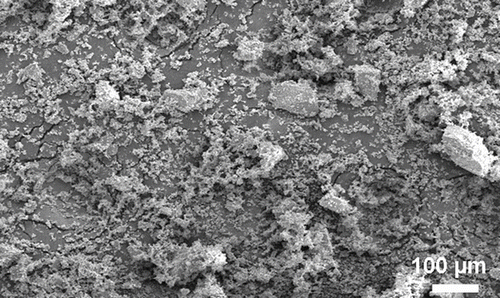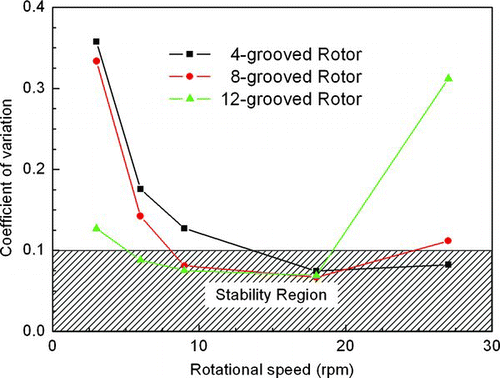Abstract
Many previous studies have examined solid-state particle discharge systems. However, several drawbacks have been encountered in terms of laboratory-scale particle feeding systems (e.g., high feeding rates, discontinuous feeding characteristics, the absence of long-term stability, and the use of high carrier gas volume rates). In this study, a state-of-the-art screw-assisted rotary feeding system was developed and evaluated in terms of aerosolization characteristics such as particle number concentration, geometric mean diameter, and geometric standard deviation. The various experimental conditions included changes in the rotational speed of the rotor, changes in the number of rotor grooves, and the existence or nonexistence of screw operation. Calcium carbonate (CaCO 3 ) powder was selected as the discharged sorbent particle. To verify the performance of the designed feeding system, we measured number concentrations with and without operation of the screw. Uniformity (i.e., the steadiness of feeding characteristics over time) was analyzed using a condensation particle counter. As the rotational speed and the number of rotor grooves increased, the number concentration and the frequency of discharging sorbent particles increased, whereas the coefficient of variation decreased. However, when the loading time was less than the critical time (∼0.8 s), the number concentration decreased and the coefficient of variation increased again according to the rotational speed. Stability (i.e., the invariability of the size distribution in various rotational speeds of the rotor for three different rotors) was also analyzed using an aerodynamic particle sizer and a scanning mobility particle sizer. The results of both aerosol measurement and scanning electron microscopy analysis showed that the geometric mean diameter and the geometric standard deviation of aerosolized sorbent particles remained constant under all the experimental conditions. We also determined that the region in which the coefficient of variation was less than 0.1 was the stable operation region for this screw-assisted rotary feeding system.
1. INTRODUCTION
Various aerosol generation systems require the transport of solid-state particulate matter at constant volume or mass, and thus many studies have examined feeding systems for the research of engine air cleaning, industrial effluent, space cleaning, and high efficiency particulate absorbing (HEPA) fields (CitationLiu 1975). CitationSchneider et al. (2007) developed a die-shoe filling system and characterized the flow behavior of pharmaceutical particles in that system. For injecting sorbent particles into a scrubber, several instruments, including rotary-, disk-, and slide-type feeders and fluidized bed solids feeders, have been examined for power plant applications (CitationFrancis et al. 2009; CitationHartman et al. 1991). CitationHiguchi and Steinhagen (1991), CitationTeague et al. (2005), and CitationVeranth et al. (2000) developed a dust feeder for use in studies of inhalation. In addition, CitationBuchanan and Schoennagel (1994) and CitationTang and Chen (1999) investigated moving-cup particulate feeders for studies of aerosol generation and control.
The basic requirements for all solid-state particle feeding systems are a means of (1) continuously providing a powder from the hopper to the body at a constant rate and (2) aerosolizing the powder with the size distribution of the original particle. The dispersibility of a powder (i.e., the ease of separating powder particles) strongly depends on the powder material, particle size and size range, particle shape, and moisture content of the powder. Incomplete dispersion results in a variation of the size distribution between the original and the aerosolized particles due to the agglomeration. To aerosolize a powder fully, sufficient energy to overcome the cohesive forces between particles are required (CitationHinds 1982).
Feeding systems are generally classified into two major categories: the volumetric type, which discharge particles of constant volume with time (e.g., screw-, turntable-, rotary-, slide-, and disk-type feeders); and the gravimetric type, which provide weighed particles (e.g., vibration and belt instruments; Gundongdu 2004). The former type is used more frequently than the latter type because of its wider variety of applications. Although transporting a constant volume of particles with small fluctuation over time and high reproducibility is the most important requirement of a feeding system, each type of feeding system has advantages and disadvantages with respect to reliability, stability and uniformity, ease of construction, and cost (CitationReist and Taylor 2000). The application of conventional feeding systems to laboratory-scale studies can involve several drawbacks, including high feeding rates, discontinuous feeding characteristics, the absence of short- and/or long-term stability, and the length of time required to stabilize the feeding process (CitationFrancis et al. 2009; CitationGundogdu 2004; CitationHartman et al. 1991; CitationKehlenbeck and Sommer 2003; CitationPohorely et al. 2004). In addition, the use of high carrier gas volume rates for transporting particles by the pressure difference between two pathways is a definite disadvantage in laboratory experiments in which residence time in the reactor according to the flow rate is an important variable (CitationReist and Taylor 2000).
Rotary feeding systems, volumetric-type feeders, are widely used in diverse industries because of their low installation cost and simple operating principle. Furthermore, rotary feeding systems can discharge both homogeneous and heterogeneous particulate matters as well as monodisperse or polydisperse materials. They also perform favorably at both high and low feeding rates. However, rotary feeding systems also have several drawbacks, such as unstable feeding characteristics, particularly when operating the system at a low feeding rate; agglomeration of particles in the hopper due to high surface activity and the presence of moisture in the atmosphere; and the repulsion of low-density particles as the height level of particulate matters in the hopper falls below a critical value when discharging heterogeneous matters (CitationGundogdu 2004; CitationYu and Arnold 1996).
To overcome these shortcomings, we developed a hybrid feeding system combining screw- and rotary-type feeding systems. Several modifications were made to realize ultra-low feeding rates with small fluctuation over time and continuous discharge of particles. This screw-assisted rotary feeding system was examined under experimental conditions in which rotor speed, the number of grooves of the rotor, and the existence or nonexistence of screw operation were manipulated. For quantitative analysis of the discharged particles, we considered the particle number concentration and size distribution in terms of the aerosolization characterization instead of the particle mass concentration evaluated in most previous studies (CitationHiguchi and Steinhagen 1991; CitationKehlenbeck and Sommer 2003; CitationPohorely et al. 2004). Calculation of number concentration is required in, for example, the sulfation process of power plants or studies of inhalation toxicity, because these processes involve the surface reactions of particulate matters. In addition, uniformity over time and stability under various feeding rates were estimated, and the available operating condition was determined based on the coefficient of variation (COV; Jung et al. 2006).
2. DESIGN OF THE SCREW-ASSISTED ROTARY FEEDING SYSTEM
A state-of-the-art screw-assisted rotary feeding system capable of supplying ultra-small quantities of sorbent particles was developed, and a detailed section view is shown in .
Calcium carbonate (CaCO3) sorbent solid-state powder (mean diameter: 19.69 μ m) was used for the test particles. These sorbent particles have often been used in examinations of the sulfation process of coal combustion power plants (CitationHartman et al. 1991). Our feeding system design is based on the same fundamental operating principle of conventional feeding systems. However, compared to existing rotary feeding systems, our system has four beneficial differences described below.
| 1. | Some particles that exhibit high surface activity may become attached to the inner surface of the hopper or agglomerate with other particles in the hopper. This hinders the smooth transportation of sorbent particles from the hopper to the rotor grooves. To overcome this problem, the hopper was equipped with a stirrer operated by a DC motor located at the top of the feeding system. | ||||
| 2. | To prevent cohesion between the sorbent particles and the hopper surface due to hydrophilicity, we surrounded the outer part of the hopper with a flexible electric heating system controlled by a proportional-integral-derivative (PID) controller. | ||||
| 3. | Conventional rotary feeding systems such as turntable/ vibration feeding systems operate by using gravity to fill sorbent particles into the grooves of the rotor (CitationSchneider et al. 2007). However, to transport an extremely small volume of sorbent particles (approximately <0.1 g/min), gravity alone is not sufficient as the driving force. To overcome this problem, we added a tiny, conically shaped screw to the lower part of the stirrer. The screw helps fill the sorbent particles into the rotor grooves. | ||||
| 4. | To discharge sorbent particles using small amounts of carrier gas, a compressed air jet was injected directly at the rotor grooves from the outlet, instead of through a suction method using the pressure gradient based on the velocity difference between the two pathways (). To prevent backflow from the outlet to the hopper through the clearance between the rotor and the body of the feeder, we installed a cap at the top of the hopper and used a silicon o-ring to seal the joint between the stirrer and the cap. | ||||
3. EXPERIMENTAL SETUP
shows a schematic of the experimental setup, which consisted of three parts: gas injection, sorbent particle injection, and measurement.
Air with a flow rate of 3 L/min, used as a carrier gas, was injected directly into grooves 2 × 1 × 5 mm3 (width × height × depth) in volume using the mass flow controller (FC-280SAV, Mykrolis, USA). Although this groove volume is extremely small, CitationHartman et al. (1991) reported that this design is adequate for continuous and stable filling to the rotor and discharging from the rotor. The air/sorbent mixture was transported to the measurement chamber at a flow rate of 3 L/min through in the inner stainless steel nozzle (ID 4.35 mm) of the two-fluid coaxial nozzle (). During this process, the mixture was floated and redispersed by the added air flow of 20 L/min (outer stainless steel nozzle; ID 10.70 mm).
In the measurement chamber, aerosolized sorbent particles expended from the nozzle were sampled using an isokinetic sampling probe with an inner diameter of 4.35 mm. The number concentration of sorbent particles <0.4 μ m in size was measured at a sampling interval of 1 s using a condensation particle counter (CPC; Model 3022A, TSI Inc., USA) to verify the uniformity of the feeding system over time (CitationJung et al. 2009a, Citation2009b). The size distribution of nanoparticles in the 21.3- to 673.2-nm size range was measured by a scanning mobility particle sizer (SMPS; TSI Inc.) composed of a 85Kr neutralizer (Model 3077, TSI Inc.), a differential mobility analyzer (Model 3071, TSI Inc.), and a CPC. Concurrently, the size distribution of microparticles in the 0.5- to 20-μ m size range was measured by an aerodynamic particle sizer (APS; Model 3321, TSI Inc.). Both sets of size distribution data were used to estimate the dependence of the output on rotational speed and the number of rotor grooves.
A diluter was used to prevent agglomeration between sorbent particles. The dilution ratios were 1:5 and 1:2 for the uniformity and stability analyses, respectively. The measured data were calculated on the basis of these dilution ratios. An impactor with orifice diameter of 0.071 cm was equipped before the SMPS and the CPC. The 50% cut-off sizes of the impactor were 0.4 μ m and 0.9 μ m for flow rates of 1.5 L/min and 0.3 L/min, respectively.
Three different rotors (30 mm in diameter) with 4, 8, and 12 grooves were used. Total number concentration, geometric mean diameter (GMD), and geometric standard deviation (GSD) were measured for each rotor at various rotational speeds from 3 to 27 rpm. The average feeding rates and COV were calculated from the total particle number concentration. The stirrer, equipped with the screw on its lower part, was rotated continuously at a speed of 12 rpm. The heating system surrounding the outer part of the hopper was set to 60°C.
To obtain a detailed analysis of the sorbent particles ejected from the feeding system with respect to morphology and polydispersity, the sampled particles were investigated by field emission scanning electron microscopy (XL30SFEG, Philips, The Netherlands) with a resolution of 1.5 nm at 10 keV. Particle deposition was prepared on standard 300-mesh grids (coated carbon copper grids).
4. RESULTS AND DISCUSSION
4.1. Use of the Screw and Its Effects
To verify the effects of the screw, we measured number concentrations of the aerosolized sorbent particles using a CPC (sampling flow rate of 1.5 L/min) both operating and not operating the screw. shows the discharge characteristics of the feeding system when the 12-grooved rotor rotated at a speed of 3 rpm for 40 min.
When the screw was not operated, the feeding system showed irregular discharge characteristics with fluctuations over time, because gravity alone was not sufficient to fill the rotor grooves with the sorbent particles. After 850 s, the screw was turned on with a speed of 12 rpm and the feeding system became stable, with an average number concentration of 2.387 × 105 particles/cm3 and a COV of 0.235.
4.2. Uniformity Analysis of Aerosolized Particles
By varying the rotational speed and the number of rotor grooves, we evaluated the aerosolized characteristics of sorbent particles by measuring the particle number concentration in real time (every 1 s).
shows the variation in the number concentration of aerosolized sorbent particles at rotational speeds from 3 to 27 rpm (using the 4-grooved rotor). As the rotational speed increased from 3 to 27 rpm, the particle number concentration increased from 1.275 × 105 (COV = 0.358) to 1.595 × 106 particles/cm3 (COV = 0.082). However, number concentration did not show a linear relationship with rotational speed. This is because this feeding system was not operated by gravity but by the driving force of the screw with constant speed of 12 rpm pushing the sorbent particles into the grooves. CitationCollins (1975) reported that rotary feeding systems are characterized by pulse-shaped particle discharges of on–off operation periods. Thus, as the rotational speed of the rotor increased, the frequency of discharging sorbent particles increased but the amplitude decreased.
FIG. 4 Number concentrations at various rotational speeds: (a) 4-grooved rotor and (b) 12-grooved rotor.
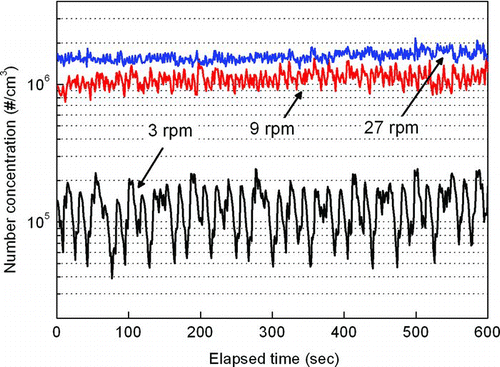

shows the variation in the number concentration of sorbent particles at rotational speeds from 3 to 27 rpm (using the 12-grooved rotor). In this experimental condition, the particle discharge characteristics were similar to those as shown in . When the speed of the rotor increased from 3 to 6 rpm, the average number concentration increased from 2.849 × 105 to 7.363 × 105 particles/cm3, whereas the COV decreased from 0.127 to 0.088. However, when the speed of the rotor increased from 6 to 18 rpm, the opposite occurred. The average number concentration decreased to 6.039 × 105 particles/cm3. When the speed of the rotor increased further from 18 to 27 rpm, the average number concentration decreased to 3.949 × 105 particles/cm3 and the COV increased to 0.312. This can be explained by the balance between the critical time and the loading time (CitationGundogdu 2004). The loading time is defined as the time interval between the first groove meeting the sorbent particle filling part of the system between the hopper and the body and the following groove in the sequence. When the loading time was long enough, the average number concentration increased and the COV decreased steadily as the rotational speed became higher. However, when the loading time was less than the critical time, the number concentration decreased and the COV increased according to the rotational speed. In this feeding system, the critical time was estimated to be approximately 0.8 s according to calculations that considered the rotational speed of the rotor and the screw, and the number of rotor grooves. We think that the critical time (∼ 0.8 s in this system) can be manipulated by controlling the rotational speed of the screw. As a result, various feeding characteristics can be expected.
The importance of the balance between loading time and critical time can be seen in , in which the number concentration of the 12-grooved rotor (7.363 × 105 particles/cm3) is slightly greater than that of the 4-grooved rotor (6.455 × 105 particles/cm3). As the number of rotor grooves increased, the frequency of aerosolizing particles increased. Meanwhile, the amplitude of the number concentration decreased. As mentioned previously, because the loading time of the 12-grooved rotor was less than that of the 4-grooved rotor, the average number concentration of the 12-grooved rotor was not simply 3 times higher than that of the 4-grooved rotor. Instead, the COV of the 12-grooved rotor was reduced by approximately half. The average number concentrations and the COVs of the 4-grooved and 12-grooved rotors at various rotational speeds are listed in .
FIG. 5 Comparison of the number concentrations for the 4- and 12-grooved rotors at a speed of 6 rpm.

TABLE 1 Average number concentration and calculated COV of the 4- and 12-grooved rotors at various rotational speeds
4.3. Stability Analysis of Aerosolized Particles
To verify the stability of the feeding system, we investigated the size distributions of aerosolized sorbent particles by using the APS and SMPS, which measure broad size ranges from a few nanometers to several tens of micrometers.
shows the size distribution of sorbent particles for the 12-grooved rotor at rotational speeds from 3 to 27 rpm. Particle number concentrations were normalized in terms of the number concentration of the size interval with the maximal number concentration value. As shown in , few variations were found in the size distribution. For convenient analysis of system stability, the GMD and GSD were considered (CitationHinds 1982).3
FIG. 6 Size distribution of aerosolized sorbent particles using the 12-grooved rotor at various rotational speeds, measured by (a) APS and (b) SMPS.
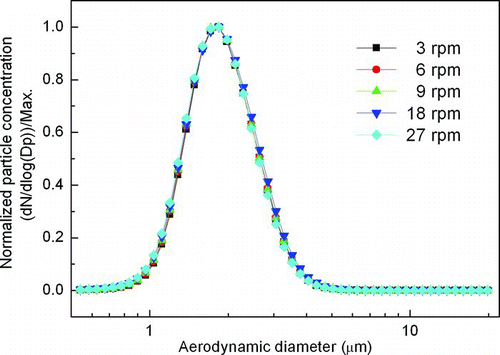

shows the GMD and GSD of aerosolized sorbent particles measured by the APS and SMPS with variation in rotational speed and the number of rotor grooves. As the speed of the 12-grooved rotor increased from 3 to 27 rpm (), the average (± SD) GMD and GSD were 1.874 ± 0.013 μ m and 1.348 ± 0.008 by APS data, respectively, and 223.4 ± 2.2 nm and 1.648 ± 0.008 by SMPS data, respectively. As the number of rotor grooves increased from 4 to 12 at a speed of 27 rpm (), the average GMD and GSD were 1.843 ± 0.006 μ m and 1.343 ± 0.006 by APS data, respectively, and 216.7 ± 3.6 nm and 1.647 ± 0.012 by SMPS data, respectively. An increase in the discharge rate of sorbent particles can cause a shift in the GMD and GSD due to the agglomeration of discharged particles (CitationFrancis et al. 2006; CitationMasuda and Gotoh 1996). In our feeding system, however, the size distributions of the aerosolized sorbent particles were sustained with only slight fluctuations in the GMD and GSD. It seems that the difference between the number concentration of the aerosolized particles according to the rotational speed or the number of rotor grooves was not enough to cause agglomeration. Dilution also has prevented the aerosolized sorbent particles from agglomerating. Furthermore, the two-fluid coaxial nozzle was adequate for sufficiently dispersing the sorbent particles. These results suggest that an optimized feeding system was developed. This system could be used to supply the required amounts of particles with small variations in GMD and GSD.
FIG. 7 GMD and GSD for (a) the 12-grooved rotor at various rotational speeds and (b) the 4-, 8-, and 12-grooved rotors at 27 rpm.
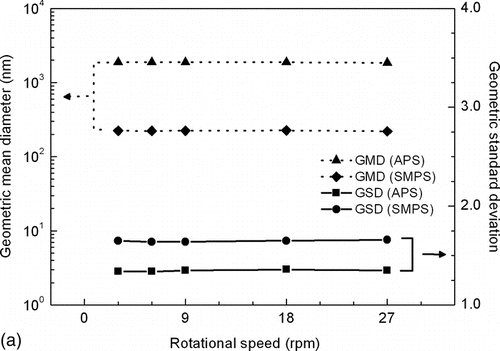
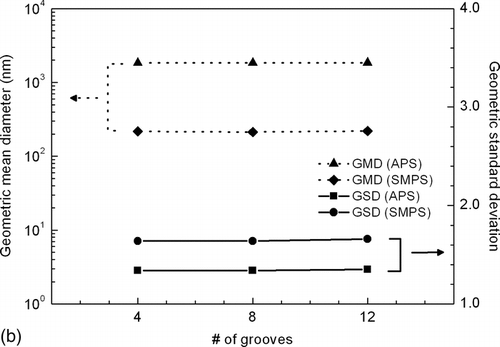
shows a scanning electron microscopy image of the discharged sorbent particles. One of the greatest problems when introducing sorbent particles into a conventional rotary-type feeding system is that the particles are held between the rotor and the body of the feeding system and become pulverized (the “cutting” phenomenon). This phenomenon often results in a shutdown of the feeding system (CitationGundogdu 1995). Yet, as shown in , a broad size distribution of aerosolized sorbent particles passed through our feeding system.
4.4. Evaluation of Operating Conditions
We also determined the stability region for the screw-assisted rotary feeding system based on operating conditions that produced uniform and stable aerosolization characteristics for sorbent particles.
shows the stability region for the 4-, 8-, and 12-grooved rotors at various rotational speeds. Considering the COV increment according to insufficient loading time after the critical rotational speed for each rotor, a COV of 0.1 was chosen as the critical value for the stability region of this feeding system. Consequently, rotational speeds of 18–27, 9–18, and 6–18 rpm were selected for the 4-, 8-, and 12-grooved rotors, respectively.
5. CONCLUSIONS
We developed a screw-assisted rotary feeding system composed of a grooved rotor, screw, stirrer, and heating system; in this study, we investigated feeding characteristics of this system in terms of uniformity and stability. When the screw was operating, the driving force of the screw made this rotary feeding system more stable for the transportation/aerosolization of extremely small amounts of sorbent particles. The number concentration and the COV of the aerosolized sorbent particles in this system could be controlled with small variations in size distribution (GMD and GSD) by the rotational speed of each grooved rotor. However, if the loading time was not sufficient, the number concentration was not proportional to the rotational speed, and the COV increased.
The proposed system for aerosolizing sorbent particles ranging in size from a few nanometers to several tens of micrometers is suitable for a variety of applications, including those involving the small-scale de-SO X process for power plants and pharmaceutical and textile research.
Acknowledgments
This work was supported by Energy Resources Technology Development Projects of the Korea Energy Management Corporation (2007-C-CD27-P-02-1-000) and the BK21 Program of the South Korea Ministry of Education, Science, and Technology.
REFERENCES
- Buchanan , J. S. and Schoennagel , H. J. 1994 . Moving Cup Particulates Feeder Used in Laboratory FCC Unit . Powder Technol , 78 ( 3 ) : 281 – 285 .
- Collins , G. F. 1975 . Measurement of Variation in Output Rate from Aerosol Generator . J. Aerosol Sci. , 6 ( 3–4 ) : 169 – 172 .
- Francis , T. M. , Gump , C. J. and Weimer , A. W. 2006 . Spinning Wheel Powder Feeding Device—Fundamentals and Applications . Powder Technol , 170 ( 1 ) : 36 – 44 .
- Francis , T. M. , Kreider , P. B. , Lichty , P. R. and Weimer , A. W. 2009 . An Investigation of a Fluidized Bed Solids Feeder for an Aerosol Flow Reactor . Powder Technol , doi:10.1016/j.powtec.2009.04.020
- Gundogdu , M. Y. 1995 . Swirling Flow Generators and Swirling Flow Separators , MS Thesis Gaziantep/Turkey : Univ. of Gaziantep .
- Gundogdu , M. Y. 2004 . Design Improvements on Rotary Valve Particle Feeders Used for Obtaining Suspended Airflows . Powder Technol. , 139 ( 1 ) : 76 – 80 .
- Hartman , M. , Svoboda , K. and Trnka , O. 1991 . Unsteady-State Retention of Sulfur Dioxide in a Fluidized Bed Continual Feeding of Lime and Limestone . Ind. Eng. Chem. Res. , 30 ( 8 ) : 1855 – 1864 .
- Higuchi , M. A. and Steinhagen , W. H. 1991 . Modification and Characterization of Dry Material Feeder Delivery of Red and Violet Dye Mixtures . Inhal. Toxicol , 3 ( 2 ) : 223 – 235 .
- Hinds , W. C. 1982 . Aerosol Technology , New York : John Wiley and Sons .
- Jung , J. H. , Oh , H. C. , Noh , H. S. , Ji , J. H. and Kim , S. S. 2006 . Metal Nanoparticle Generation Using a Small Ceramic Heater with Local Heating Area . J. Aerosol Sci. , 37 ( 12 ) : 1662 – 1670 .
- Jung , J. H. , Lee , C. H. , Lee , J. E. , Lee , J. H. , Kim , S. S. and Lee , B. U. 2009a . Design and Characterization of a Fungal Bioaerosol Generator Using Multi-Orifice Air Jets and a Rotating Substrate . J. Aerosol Sci. , 40 ( 1 ) : 72 – 80 .
- Jung , J. H. , Lee , J. E. and Kim , S. S. 2009b . An Evaluation Method for Spore Concentration Uniformity on a Fungal Substrate: Use of a Real-Time Aerosolization Technique . Environ. Eng. Sci , 26 ( 4 ) : 861 – 866 .
- Kehlenbeck , V. and Sommer , K. 2003 . Possibilities to Improve the Short-Term Dosing Constancy of Volumetric Feeders . Powder Technol , 138 ( 1 ) : 51 – 56 .
- Liu , B. Y. H. 1975 . Fine Particles: Aerosol Generation, Measurement, Sampling, and Analysis , 146 New York : Academic Press .
- Masuda , H. and Gotoh , K. 1996 . Dry Dispersion of Fine Particles . Colloids and Surfaces A: Physicochemical and Engineering Aspects , 109 : 29 – 37 .
- Pohorely , M. , Svoboda , K. and Hartman , M. 2004 . Feeding Small Quantities of Particulate Solids . Powder Technol. , 142 ( 1 ) : 1 – 6 .
- Reist , P. C. and Taylor , L. 2000 . Development and Operation of an Improved Turntable Dust Feeder . Powder Technol. , 107 ( 1–2 ) : 36 – 42 .
- Schneider , L. C. R. , Sinka , I. C. and Cocks , A. C. F. 2007 . Characterisation of the Flow Behaviour of Pharmaceutical Powders Using a Model Die-Shoe Filling System . Powder Technol. , 173 ( 1 ) : 59 – 71 .
- Tang , L. and Chen , W. Y. 1999 . Improvements on a Particle Feeder for Experiments Requiring Low Feed Rates . Review of Scientific Instruments. , 70 ( 7 ) : 3143 – 3144 .
- Teague , S. , Veranth , J. , Aust , A. and Pinkerton , K. 2005 . Dust Generator for Inhalation Studies with Limited Amounts of Archived Particulate Matter . Aerosol Sci. Technol. , 39 ( 2 ) : 85 – 91 .
- Veranth , J. M. , Smith , K. R. , Aust , A. E. , Dansie , S. L. , Griffith , J. B. , Hu , A. A. , Huggins , M. L. and Lighty , J. S. 2000 . Coal Fly Ash and Mineral Dust for Toxicology and Particle Characterization Studies: Equipment and Methods for PM2.5- and PM1-Enriched Samples . Aerosol Sci. Technol. , 32 ( 2 ) : 127 – 141 .
- Yu , Y. and Arnold , P. C. 1996 . The Influence of Screw Feeders on Bin Flow Patterns . Powder Technol. , 88 ( 1 ) : 81 – 87 .
